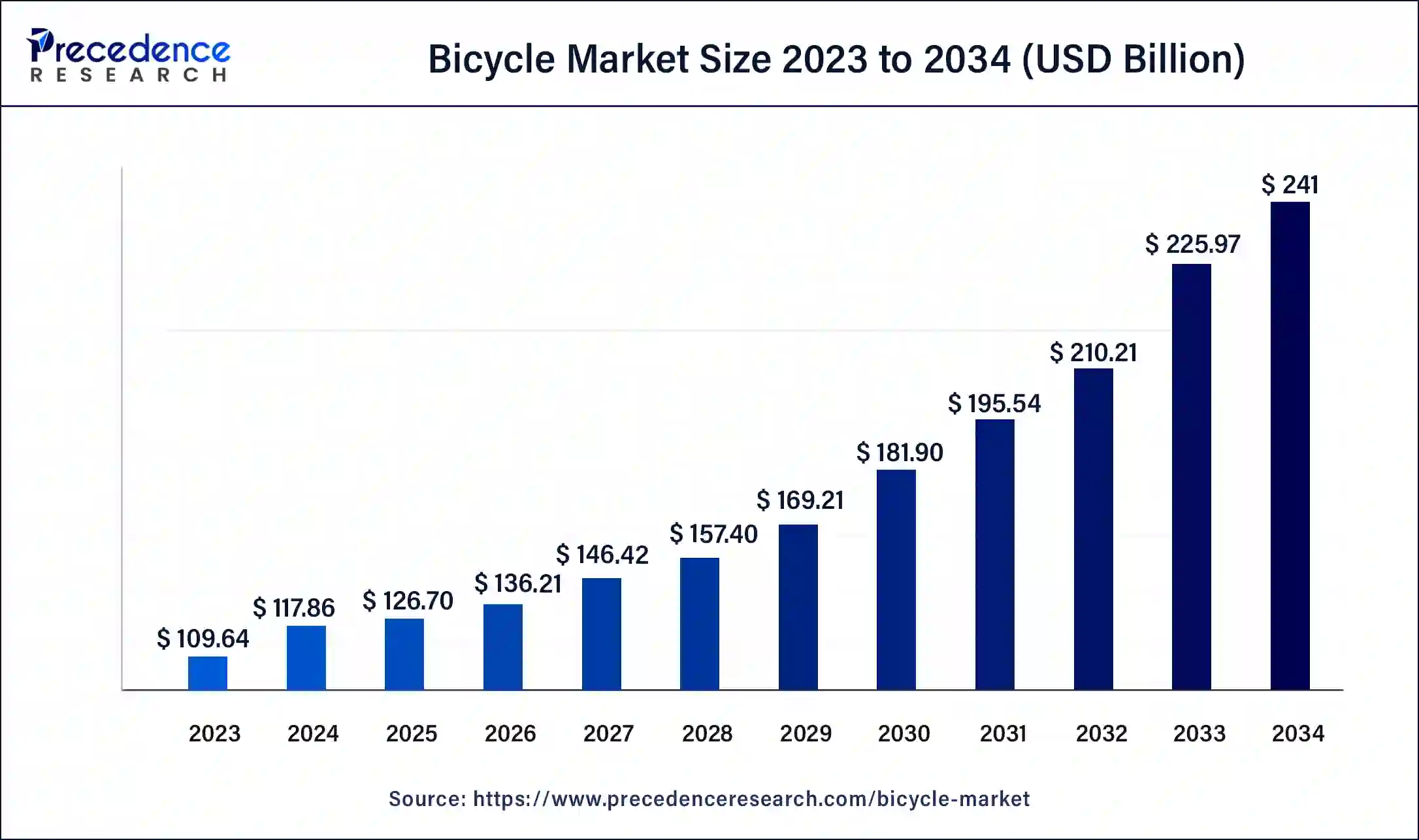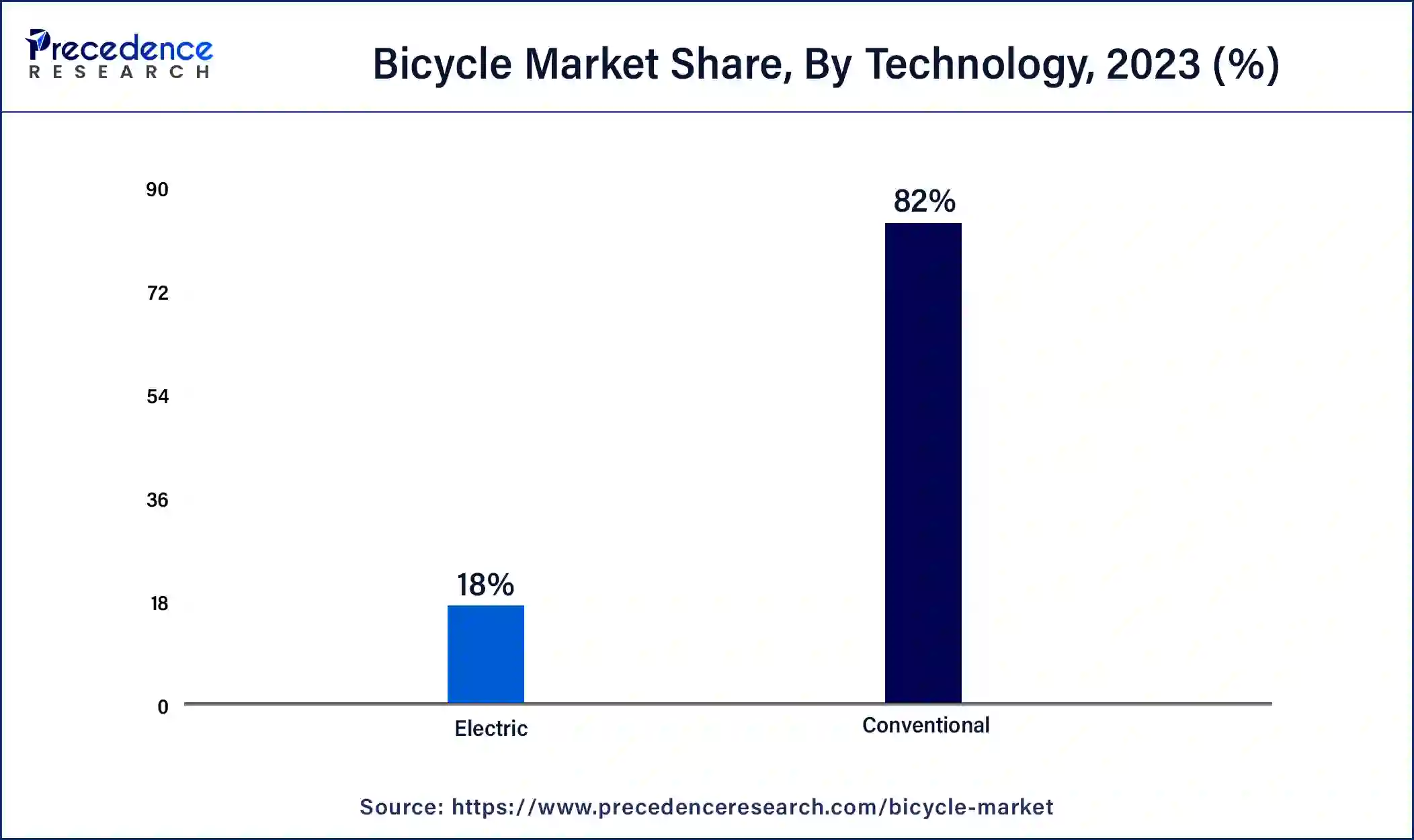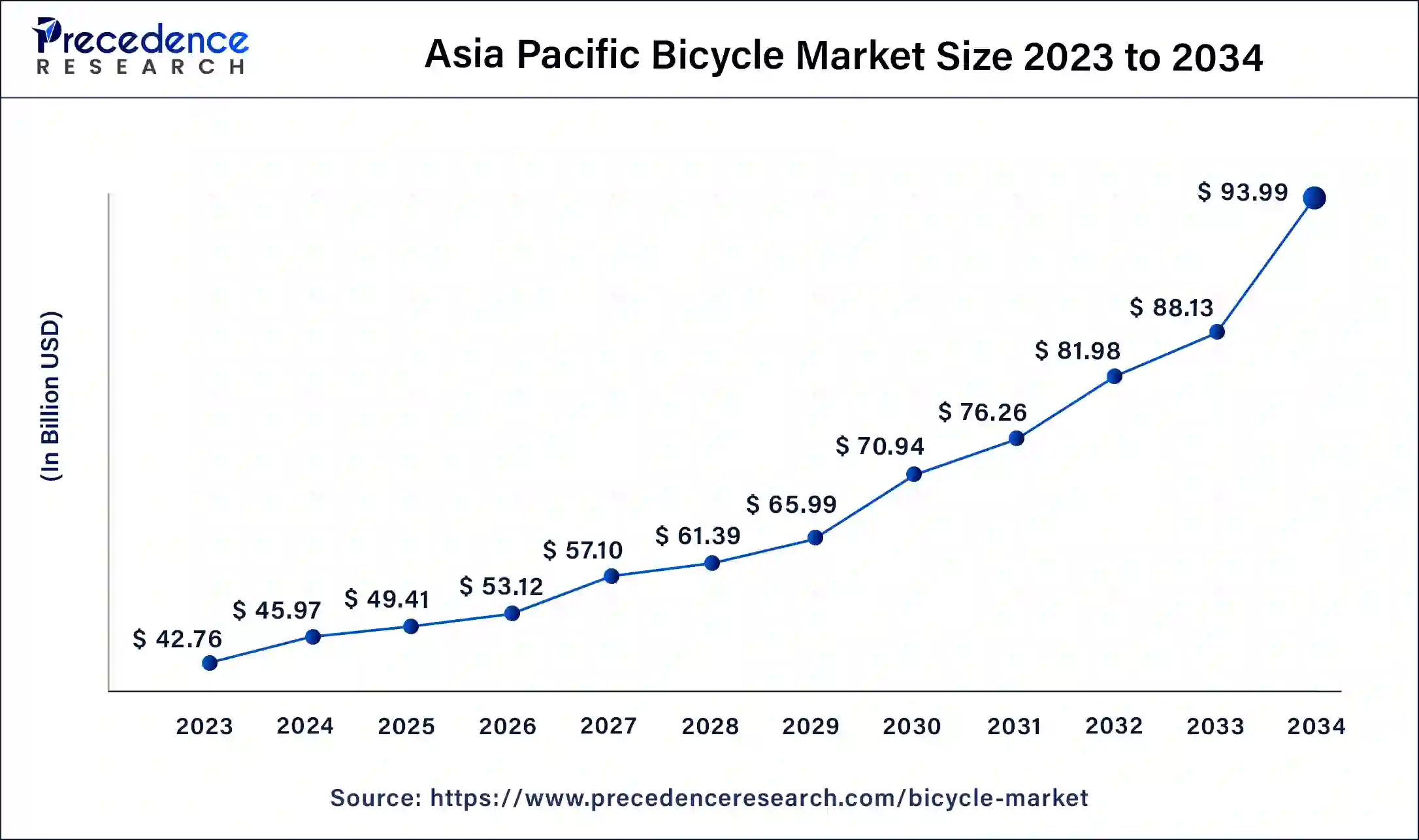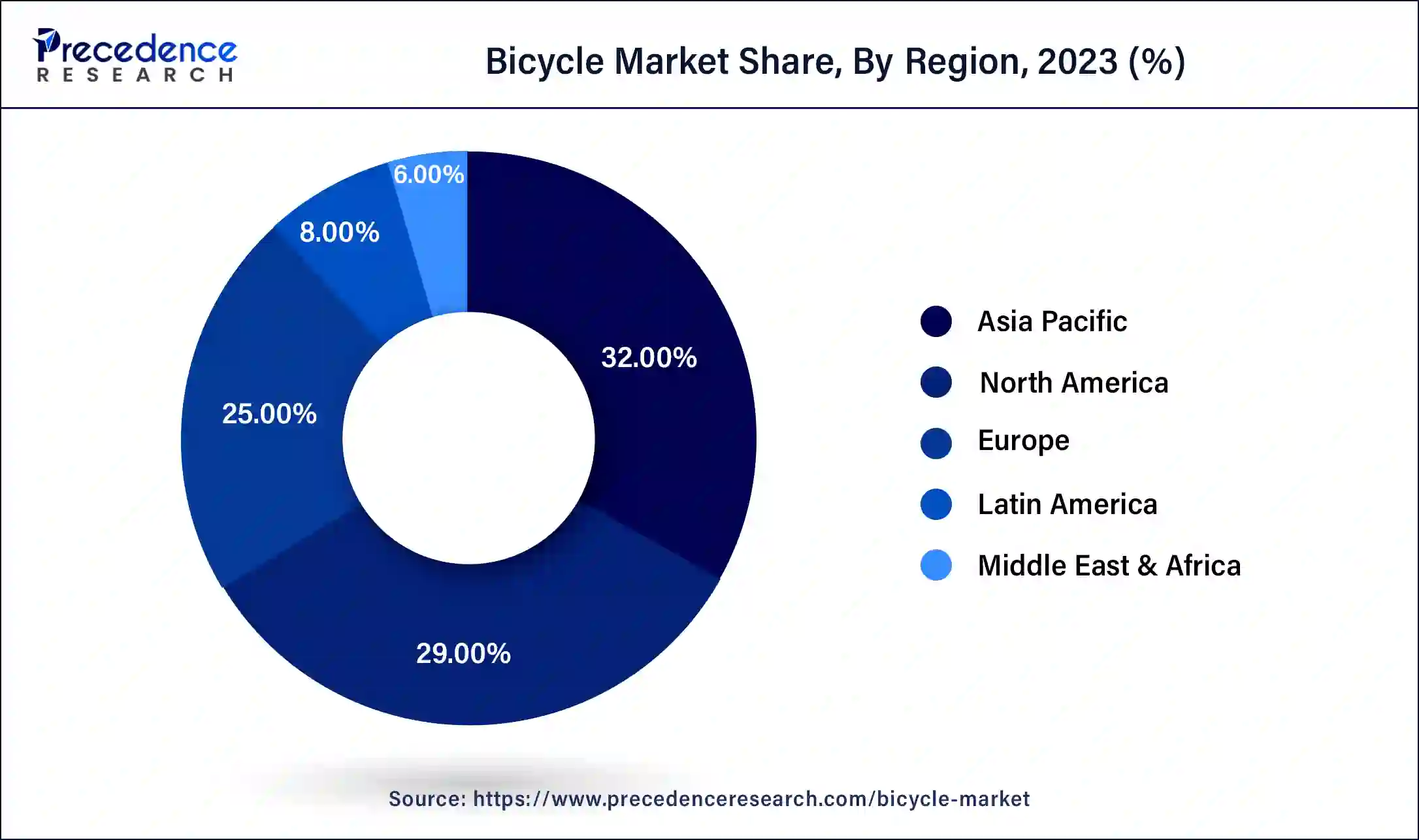List of Contents
What is the Bicycle Market Size?
The global bicycle market size is valued at USD 126.7 billion in 2025, calculated at USD 136.21 billion in 2026 and is expected to reach around USD 241 billion by 2034, expanding at a CAGR of 7.42% from 2025 to 2034.

Market Highlights
- Asia Pacific led the global market with the highest market share of 31.27% in 2024.
- By technology, the conventional segment has held the largest market share of 82% in 2024.
- By product, the road bicycle segment captured the biggest revenue share of 41% in 2024.
- By distribution channel, the commercial segment registered a maximum market share of 52% in 2024.
Market Size and Forecast
- Market Size in 2025: USD 126.7 Billion
- Market Size in 2026: USD 136.21 Billion
- Forecasted Market Size by 2034: USD 241 Billion
- CAGR (2025-2034): 7.42%
- Largest Market in 2024: Asia Pacific
Bicycle Market Growth Factors
The rising preferences among the consumers for bicycle as a form of leisure are expected to boost the growth of the global bicycle market. Bicycles are a convenient form of exercise and it is highly demanded among the consumers to ensure active and healthy lifestyle, obesity free life, and free from various diseases. The rising awareness among the population regarding the health benefits of riding bicycle is boosting the demand for bicycles across the globe. Moreover, the dockless bicycle sharing systems are gaining a rapid traction among the population which is expected to boost the growth of the global bicycle market. The bicycle sharing systems provide users to locate nearby bicycle and unlock electronically. The dockless bicycle sharing systems has originated in Europe and is gaining rapid popularity in developing regions like Asia Pacific. The proliferation of digital technologies and rising penetration of internet and smartphones across the globe has led to the advancements in mobile application development and the GPS systems which plays a significant role in the development of the dockless bike cycle sharing system. The rising investments by various companies in the bicycle sharing systems in various regions are expected to drive the growth of the bicycle market.
The events like Ronde van Vlaanderenare and Tour de France are spreading awareness regarding the benefits of bicycling among the people. Consumers are increasingly adopting bicycles as a regular form of exercises to fight against obesity. The rising incidences of obesity across the globe are a prominent factor behind the rising demand for the bicycles. According to the World Health Organization, over 1.9 billion adults aged 18 years or above were overweight in 2016. About 650 million out of it were obese. Therefore, a significant rise in the obesity in the global population is expected to boost the demand for the bicycles in the upcoming future.
MarketScope
| Report Coverage | Details |
| Bicycle Market Size in 2025 | USD 126.7 Billion |
| Bicycle Market Size in 2026 | USD 136.21 Billion |
| Bicycle Market Size by 2034 | USD 241 Billion |
| Growth Rate from 2025 to 2034 | CAGR of 7.42% |
| Base Year | 2024 |
| Forecast Period | 2025 to 2034 |
| Segments Covered | Product, Technology, Distribution Channel, End User, Price, and Region |
| Region Covered | North America, Europe, Asia-Pacific, Latin America, and Middle East & Africa |
Market Dynamics
Drivers
Increased Use of Bicycles for Commuting
Urban sprawl and increased fuel prices have led to a change in commuting habits from cars to bicycles. The World Economic Forum estimates that in 2024, bicycling rose by 200% in cities like New York. Governments are increasing their spending on cyclist infrastructure. In Paris, city officials committed $290 million to new bike lanes. This increase in cycling infrastructure is encouraging more people to ride in urban environments, with governments making it a safer and easier choice for commuting. Adding to infrastructure developments, health-conscious consumers are embracing cycling as a physical activity, which will continue to drive the trend among urban centres around the world.
Opportunity
Rise in e-bike demand and popularity
The recent growth of electric bicycle (e-bike) ownership has provided new opportunities in the market. Deloitte's 2024 report on the cycling market reported that global e-bike sales reached sitting at 60 million units, due to the green push and demand for new assisted mobility solutions. Government schemes are also facilitating e-bike production and increasing e-bike uptake. Schemes such as India's FAME II, EU grants for green mobility solutions have unfolded the segment as an option for growth in the bicycle market. The advancements in battery technology and features such as IoT integration aim to make e-bikes the first choice for modern mobility.
Segments Insights
Technology Insights
The conventional segment captured a market share of around 82% and dominated the global bicycle market in 2023. The conventional bicycles are cheaper, involves low maintenance cost, and it is convenient as compared to the electric bicycles. This is a major factor behind the huge revenue share of the conventional bicycles. Apart from a convenient mode of transport, the bicycling is emerging as a popular sport and a form of leisure across the globe. In terms of technology, the bicycles for women is the leading the bicycle market all over the globe. The rising government expenditures and rising government initiatives to construct a separate route for bicycles and promote the adoption of bicycles is expected to boost the growth of the global bicycle market significantly in the forthcoming years.

The electric bicycle segment is anticipated to be the most opportunistic segment and is projected to grow at a CAGR of around 10.3% from 2025 to 2034. The rising adoption of electric bicycles owing to the ease of use and convenience and the faster journey offered by it as compared to the conventional bicycles is boosting the demand for the electric bicycles among the consumers. Furthermore, the advancements in the battery, higher capacities of the electric batteries, and longer lifecycle are the major features of the electric bicycles that are expected to drive the growth of the electric bicycle market during the forecast period.
Product Insights
The road bicycle segment constituted around 41% of the revenue share in 2024 and dominated the global bicycle market. The road bicycles are the basic bicycles adopted the consumers that do not requires any special accessories as required in mountain, racing, and other bicycles. Most of the consumers also tend to customize their bicycles as per the need and the customizability associated with the road bicycles has led to its higher demand across the globe. Hence, this segment is expected to retain its dominance throughout the forecast period.
Cargo bikes segment is expected to be the fastest-growing segment during the forecast period. The rising adoption of the bicycles in order to replace the use of motorized vehicles for short distance applications is boosting the growth of the cargo bikes across the globe.
Distribution Channel Insights
The offline channel segment led the global bicycle market, accounting for a market share of around 52% in 2024. This is attributed to the increased preference for the offline channels among the consumers to buy bicycles. The offline channel offers test drive option, variety of features and colors, options for personalization or customization, and instant product delivery that has boosted the sales of the bicycles from the offline distribution channels. Furthermore, the offline stores has a wider range of brands and bicycles that attracts the customers.

The online channel is expected to be the most opportunistic segment during the forecast period. The growing penetration of the internet, rising adoption of smartphones, growing number of internet users, free home delivery, easy return and replacement, easy payment options, and huge discounts offered by the online retailers are the prominent factors that are significantly driving the growth of the online sales channels across the globe. According to the International Telecommunications Union, around 64% of the global population had access to the internet in 2021 and this number is expected to grow significantly in the upcoming future.
Regional Insights
Asia Pacific Bicycle Market Size and Growth 2025 to 2034
The Asia Pacific bicycle market size is estimated at USD 40.54 bllion in 2025 and is predicted to be worth around USD 78.33 billion by 2034, at a CAGR of 7.58% from 2025 to 2034.

Asia Pacific accounted for a market share of around 31.27% and dominated the global bicycle market in 2024. The various nations in Asia Pacific like Japan, China, and Singapore are investing heavily in the development of the necessary infrastructure that supports and encourage commutation through bicycles. The high number of road traffic accidents is the major restrain that may hamper the growth of the bicycle market in Asia Pacific region. The presence of huge youth population and rapidly ageing population in this region are becoming aware regarding the health benefits of bicycling and the rising disposable income and growing desire to remain healthy and fit is boosting the demand for the bicycles across the Asia Pacific region.

Europe is expected to grow at the highest CAGR of 10.5% during the forecast period. This growth is attributable to the presence of supportive infrastructure in several cities that encourages the adoption of bicycles. Furthermore, the events like Ronde van Vlaanderenare and Tour de France contribute significantly towards the adoption of the bicycles among the consumers. Various European nations like Denmark, Italy, Belgium, and France are rolling out bicycle-friendly infrastructure that promotes commutation through bicycles. The rising concerns over the carbon emission from vehicles and rising incidences of overweight and obesity is further fueling the demand for the bicycles among the European population.
Bicycle Market Companies
- Trek Bicycle Corporation
- Accell Group
- SCOTT Sports SA
- Atlas Cycles Ltd.
- Specialized Bicycles Components, Inc.
- Avon Cycles Ltd.
- Merida Industry Co. Ltd.
- Cervelo
- Giant Bicycles
- Dorel Industries Inc.
Recent Developments
- In January 2025, Ultraviolette launched its latest F77 model and which is called the F77 SuperStreet. this one is a more street-oriented electric motorcycle and bears a bunch of new bits when compared to the Mach 2. Ultraviolette will commence the bookings for the F77 SuperStreet.
- In April 2024, LOBO EV Technologies Ltd., an innovative electric vehicle manufacturer and seller, announced its new strategic collaboration with Serbian distributor CSM2017 Doo (“CSM2017”), marking a milestone in its expansion into the burgeoning electric vehicle market in Eastern Europe.
- In January 2025, AOKI Mobility introduced a new range of e-bicycles designed for sustainable urban transport. The models include Sherpa for mountains, Flex for folding, and Cadence for city use. Flex is notable for being lightweight with an 80 km range. The launch supports AOKI's goal of producing 80,000 e-bicycles, aiming to enhance urban mobility.
- In June 2019, Trek Bicycle Corporation launched Madone SLR 6 Disc Speed, which is integrated with removable aero bars and it facilitates commute in hilly areas.
Segments Covered in the Report
By Product
- Hybrid Bikes
- Mountain Bikes
- Cargo Bikes
- Road Bikes
- All Terrain Bicycle
- E-bicycle
- Others
By Technology
- Conventional
- Electric
By Distribution Channel
- Online
- Offline
By End User
- Men
- Women
- Kids
By Price
- Premium
- Mid Range
- Low Range
By Region
- North America
- Latin America
- Europe
- Asia-pacific
- Middle and East Africa
For inquiries regarding discounts, bulk purchases, or customization requests, please contact us at sales@precedenceresearch.com
Frequently Asked Questions
Tags
Ask For Sample
No cookie-cutter, only authentic analysis – take the 1st step to become a Precedence Research client